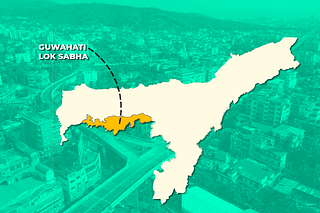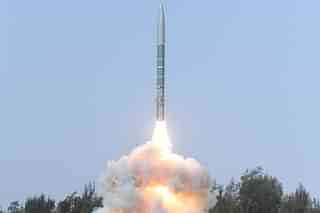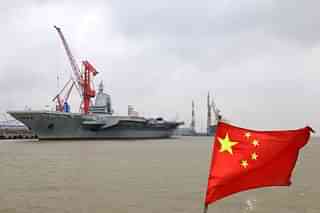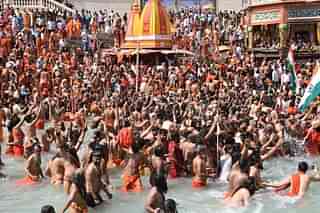Reports
Moradabad Files: How Gangrape Of Dalit Girl By Muslim Youths Led To Communal Riots In 1980 Killing Over 100
Swati Goel Sharma
Aug 14, 2023, 06:00 PM | Updated 08:17 PM IST
Save & read from anywhere!
Bookmark stories for easy access on any device or the Swarajya app.
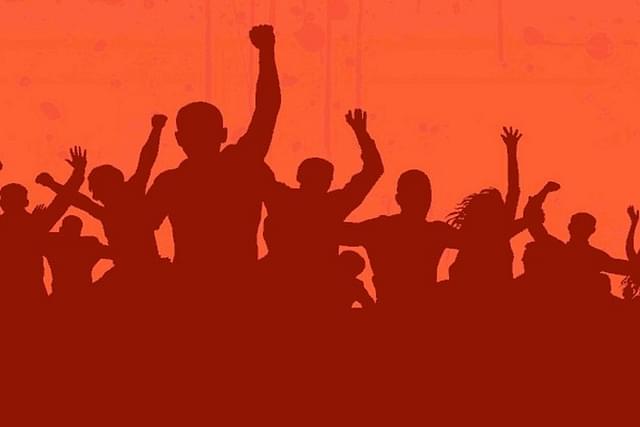
Last week, the Uttar Pradesh government tabled in the Assembly a judicial commission report in the 1980 Moradabad riots, triggering a political slugfest on the timing of its release.
The report was prepared by a retired judge of the Allahabad high court, Justice MP Saxena, in the aftermath of the riots and was commissioned by the then Congress government led by chief minister VP Singh.
No governments in the state, whether those led by the Congress, Samajwadi Party, Janata Dal or Bharatiya Janata Party, made the report public until the current CM, Yogi Adityanath, took the initiative.
The 1980 riots in the Moradabad district of UP claimed deaths of at least 100 people.
Popular narrative on the riots so far
The narrative around the riots so far has been this: On the morning of 13 August, 1980, around 50,000 Muslims had gathered at the Idgah for Id namaz. A “pig was let loose into the Idgah” and some Muslims asked the “mostly Hindu” policemen deployed at the spot to remove it. The police did not take any action.
Angered, some men entered an altercation with the police who retaliated by firing indiscriminately at Muslims. Soon, violence spread to other areas and took a communal turn, ending up in Hindu-Muslim violence (information taken from Washington Post and New York Times reports from that year, and Wikipedia).
In his book Riot after Riot, ex-journalist and BJP MP MJ Akbar described the violence as a “massacre of Muslims” by “rabidly communal police” (page 33 onwards).
He wrote, “Men from the Provincial Armed Constabulary (PAC) opened fire on about 40,000 Muslims while they were at their Id prayers. No one knows exactly how many people died. What is known is that the incident at Moradabad was not a Hindu-Muslim riot but a calculated cold-blooded massacre of Muslims by a rabidly communal police force which tried to cover up its genocide by making it out to be a Hindu-Muslim riot”.
The book quoted an unnamed eyewitness that Muslims asked the police how a pig, considered unclean by the community, had wandered into the namaz despite their presence, to which cops replied that it was not their job to prevent pigs from entering Idgah.
The author then quoted a “friend” who compared the entry of a pig into namaz with slaughter of a cow in front of the temple and said that “it was provocative”. The book further says that an “altercation” happened and, within five minutes, “the police opened fire”.
On the other hand, a report on the riots by Economic and Political Weekly published after the riots said the police fired in panic after some officers were "lynched" by the crowd.
The report said, “Somehow the impression spread among the Muslims that the police had been responsible for the entry of the pig and the agitated crowd started throwing stones at the police. The policemen on the spot who were few in number and without arms tried to resist but were powerless before the angry mob which started beating the policemen…A stone hit the SSP in the forehead and he collapsed. The ADM, DP Singh, was dragged away by some persons and was later found to have been beaten to death”.
The EPW report further said that the firing was most probably started by the police as they were under attack and panicky.
“The lynching of some policemen by the crowd made them fire indiscriminately into the crowd,” the report, authored by Krishna Gandhi, said. Angry mobs, chanting “kill the police” scattered in the city and their first target was Gali Shaheed police chowki near the Idgah. Cops were beaten up and the chowki was set on fire, the report added.
What the Justice Saxena report says
The one-man commission report by Justice Saxena was submitted in May 1983. Before that, Yogendra Makwana, the Union Minister of State for Home Affairs, had accused the BJP (established in April 1980) and Rashtriya Swayamsevak Sangh (RSS) of orchestrating the riots.
The just-released 500-page report by Justice Saxena, accessed by Swarajya, however absolves the RSS and the BJP of any misconduct. Instead, the report wholly attributes the violence to communal politics played by some Muslim political leaders.
Below is the narration of events as happened in the 1980 violence in Moradabad, as described in the Justice Saxena report:
Moradabad, a district known for its brassware industry, was not free of communal violence even before the Idgah incident. Its cities and towns saw communal violence in 1971, 1975 and 1978 too.
The politics of Moradabad in 1980 was such that Dr Shamim Ahmed Khan had revived the Muslim League in the area and was trying to take on Hafiz Mohammed Siddiqui of the Congress Party. Siddiqui had the support of Muslims as well as Hindu communities of Punjabi and Valmiki castes in the area.
About three months before the violence, a minor disturbance was witnessed ahead of the May elections when an injured cow was let loose in the market in the hope that it would anger Hindus and prevent them from supporting Siddiqui for being Muslim.
However, the incident had failed to cause any unrest among Hindus and they voted for Siddiqui, defeating both Khan and a Punjabi Hindu candidate named Hansraj Chopra.
In the same month, that is May, a girl from the Dalit Valmiki community, about 17 or 18 years of age, was kidnapped by local Muslim youths led by one Mohammed Riyaz, and gangraped. She had gone to clean a building. Khan, in order to raise his status among the Muslims, sided with the accused.
The Dalit family grew scared of the political backing for the accused and, fearing for their daughter’s life, quickly arranged her marriage.
On 27 July, her marriage procession was being taken out in the town when it was pelted with stones near a mosque. Muslims concocted the reason for the attack as the procession playing music outside the mosque during the time of Iftar (breaking up of Roza fast).
It was a lie because the baraat crossed the mosque much before the evening hours of Iftar. Rioters pelted stones at houses of Valmikis and even set their houses on fire. Khan had instigated the crowd.
In another incident that Khan tried to communalise to emerge as the biggest sympathiser of Muslims, one Bhure Ali and some people were accosted on their way and beaten up.
Javed and his friends were held for the assault by police. However, Javed died in police custody. Khan led a campaign that Javed was killed by the police. Despite orders by administration, a juloos (funeral procession) was taken out of Javed.
Meanwhile, following the attack on Valmikis, the community stopped cleaning the toilets of Muslim colony from 24 July onwards. In revenge, Muslims poisoned some pigs reared by Valmikis. Khan’s popularity among Muslims was rising.
The trouble on 13 August was premeditated, brought out by the fact that two police complaints of communal nature were given by the Muslim community on the evening of 12 August.
This was done to put the blame on Valmikis and Punjabi Hindus for the incidents to follow (details of the case are not mentioned in the commission’s report).
The tale of a pig entering the namaz area was a concoction. No evidence was ever found of a pig straying or being let loose into the Idgah. Muslims consider pigs as unclean and believe their prayers disrupted by sight of a pig.
The rumour of a pig was followed by further rumours of police having killed thousands of Muslims during prayers. These instigated large-scale attacks by Muslims who indulged in rioting while chanting “kill policemen and Hindus, and burn their houses”.
Police chowkis and thanas were attacked followed by bastis of Hindus. Soon, Hindus retaliated and full-fledged communal violence broke out. Police tried to control it but it spread to other parts of the town in no time.
The town came to a halt; government offices stopped working. A total of 84 deaths were recorded in the coming days belonging to both Muslims and Hindus. A total of 20 sites in Moradabad were affected by the violence.
In areas such as Idgah, Barafkhana and Bhoora ka Chauraha, most deaths occurred due to stampede.
What the report by Justice Saxena concludes
The report, after narrating this sequence of events, concluded that the administration could not be held responsible for the violence, nor the local Hindus. There was no role found of the RSS or the BJP.
District magistrate SP Arya and police chief VN Singh had taken the necessary precautions. Even the common Muslim could not be held responsible. It was solely orchestrated by Dr Shamim Ahmed Khan and another leader of Muslim League, Hamid Hussain alias Ajji.
Save & read from anywhere!
Bookmark stories for easy access on any device or the Swarajya app.
Swati Goel Sharma is a senior editor at Swarajya. She tweets at @swati_gs.
Support Swarajya's 50 Ground Reports Project & Sponsor A Story
Every general election Swarajya does a 50 ground reports project.
Aimed only at serious readers and those who appreciate the nuances of political undercurrents, the project provides a sense of India's electoral landscape. As you know, these reports are produced after considerable investment of travel, time and effort on the ground.
This time too we've kicked off the project in style and have covered over 30 constituencies already. If you're someone who appreciates such work and have enjoyed our coverage please consider sponsoring a ground report for just Rs 2999 to Rs 19,999 - it goes a long way in helping us produce more quality reportage.
You can also back this project by becoming a subscriber for as little as Rs 999 - so do click on this links and choose a plan that suits you and back us.
Click below to contribute.

